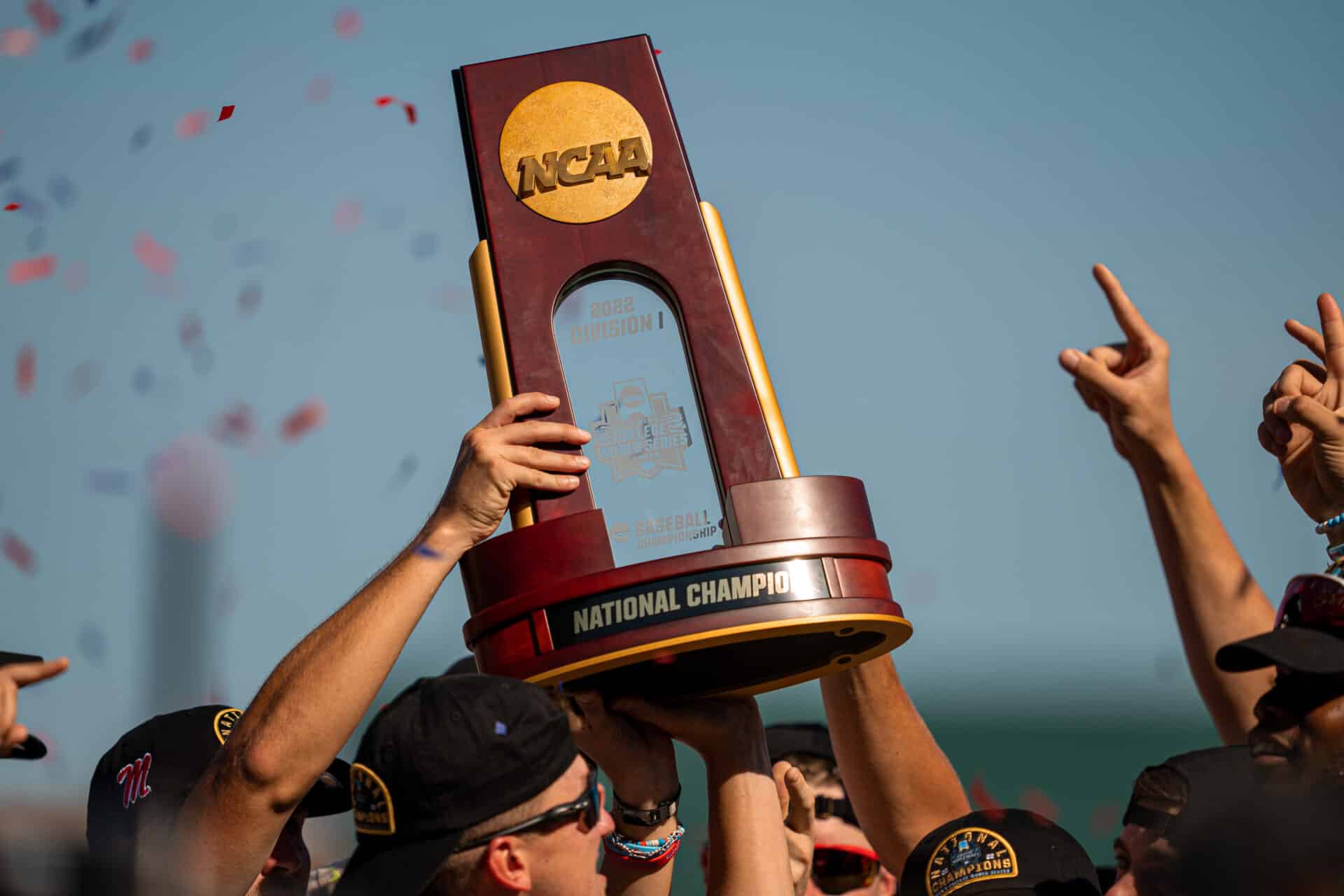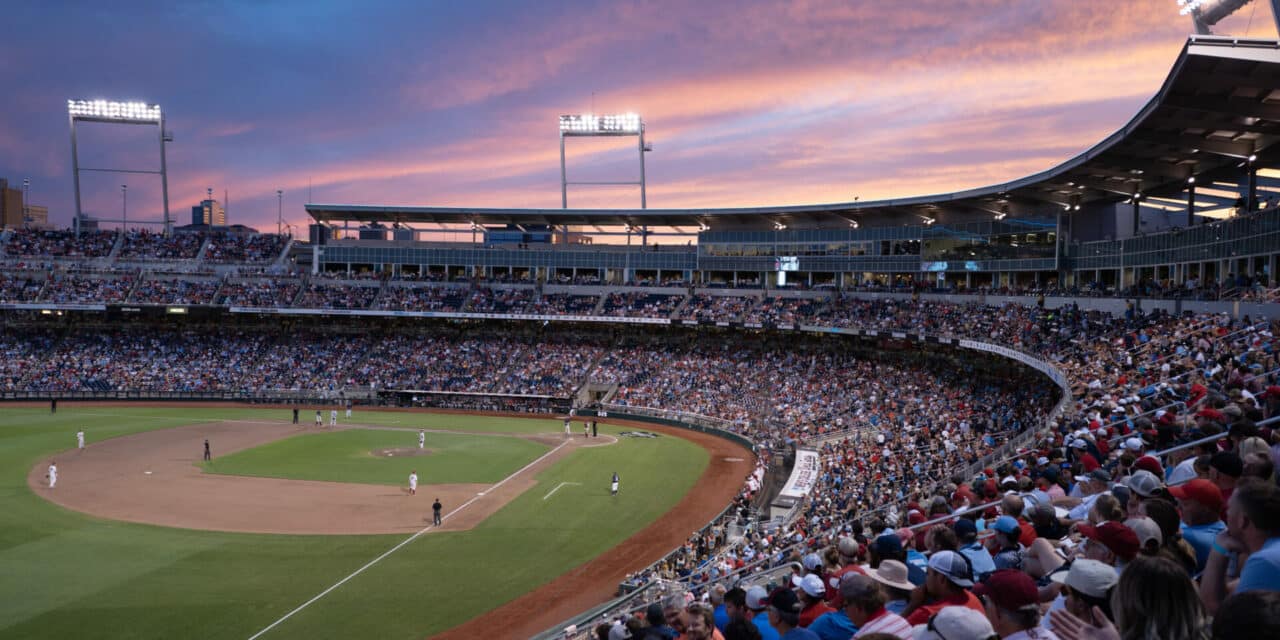HOMESPUN HOME RUN: Charles Schwab Field Omaha hosts the annual College World Series and is also home to the Creighton Bluejays men’s baseball team. (Eric Francis/Getty Images)
In locker rooms and baseball stadiums across the country there are signs that read: “The road to Omaha starts here.” It’s meant to inspire athletic excellence, but it is also a source of pride for the city the men’s NCAA College World Series has called home since 1950.
While other high-profile NCAA championships for men’s football and basketball travel from venue to venue, the College World Series has become a fixture each June at Charles Schwab Field Omaha, where it will remain through the 2036 series.
It’s known as the “Hometown Home Run.”
“These teams are so successful and have these huge programs and they build these giant complexes and in all their locker rooms there’s one main piece that says, ‘Road to Omaha.’ That’s the message,” said Amy Hornocker, executive director of College World Series of Omaha, Inc. “So, it doesn’t matter what part of the country you are from, this is the ultimate goal.”
“I moved here 22 years ago and the whole city takes it in,” said Roger Dixon, president and CEO of the Metropolitan Entertainment and Convention Authority, the non-profit organization that builds and manages public event venues in Omaha including CHI Health Center Omaha and Charles Schwab Field Omaha. “The atmosphere, the vibe in the city, the bars that are open before the games after the games, the tailgating that goes on. To get a hotel room is a task because people come in from all over.”
The championship is the culmination of a winning season and an economic boost for the city.
Based on research conducted by Creighton University economists Ernie Goss and Scott Strain, the College World Series had an economic impact of $88.3 million and supported 1,100 year-round jobs — from providing fireworks to sewing patches on uniforms — in 2019; compared to $63.2 million and 777 jobs in 2014.
“There are numerous calculators out there, but at this point I guess we are probably over $90 million,” said Hornocker, whose group commissioned the study.
“The Omaha community has been a tremendous partner with the NCAA in hosting the Men’s College World Series since 1950,” said Michelle Hosick, NCAA director of communications. “Generations of fans journey to the city each year in one of the greatest traditions in sports. The NCAA and the entire college baseball community truly value Omaha’s support of student-athletes as they strive to achieve the pinnacle of their athletics career.”

The Ole Miss Rebels hoist the The National Championship trophy after winning last year’s Men’s College World Series over Oklahoma June 26, 2022.
The road to Omaha starts with 64 teams competing in regional tournaments. Sixteen teams advance to the super regionals and the eight winning teams head to Omaha for the College World Series, which runs through June 26. There they are split into two double-elimination brackets, consisting of four teams each. The winners of the two brackets meet in the finals in a best-of-three series to decide the NCAA champion.
The first NCAA Division I baseball tournament was in 1947 and featured eight teams. The two winners – University of California and Yale – then met in a best-of-three final at Hyames Field in Kalamazoo, Michigan. California went undefeated to capture the first title.
The tournament was held in Kalamazoo again in 1948 and moved to Lawrence Stadium in Wichita, Kansas, in 1949 before taking up permanent residence at Omaha Municipal Stadium in 1950 after a successful pitch to the NCAA by then Omaha Mayor Johnny Rosenblatt, a baseball fan and former player, and a group of city business leaders called the “founding fathers.”
Lauded for his vision, Omaha Municipal Stadium was renamed Johnny Rosenblatt Stadium in 1964. In 1967 the College World Series of Omaha, Inc. (CWS Omaha), the non-profit group that acts as the local organizing committee, was established and helmed for 30 years by John D. Diesing Sr.
Johnny Rosenblatt Stadium was beloved but beleaguered. To retain the series for the long-term, the CWS Omaha agreed to construct a new facility three miles away near CHI Health Center Omaha. Through a public-private arrangement, the $140 million TD Ameritrade Park of Omaha opened in 2011 with a capacity of 24,000, but it was built for expansion with seating for an additional 10,000 patrons.
The series “outgrew Rosenblatt,” Hornocker said. “It had its historical beauty and it was more of a fairgrounds-type atmosphere. You would park in people’s front yards. As college baseball has progressed and as these teams have become huge powerhouses, it was time to move to a venue that fit.”
Serving 24,000 fans has its challenges. Games are stacked, which can lead to issues when games go into extra innings. Clearing the house, cleaning and reopening gates an hour later takes cooperation from fans and an efficient cleaning crew, which numbers between 80 and 100, according to Dixon. Food purveyor Levy Restaurants provides hot dogs and signature dishes.
“There are people who take vacations every year during that time frame so they can be at every game,” said Dixon. “There are people who want to work every single game and there are people who want to attend every single game.”
Being in a fixed location for the College World Series provides the ability to sell season tickets. Some of the 12,000 season ticket holders date back to the 1970s and pass the tickets down through generations. In 2022, attendance was 339,000 through the turnstiles, according to Dixon.
The stadium was renamed Charles Schwab Field Omaha in 2023. Along with the College World Series, the stadium is the home field for the Creighton Bluejays men’s baseball team and hosts numerous other events such as the Big Ten and Big East baseball tournaments.
“What makes Omaha great about embracing these events is that we don’t have professional teams,” said Hornocker, whose former post was with the city’s sports commission. “Anything that’s amateur or sports that comes in here, people are excited about it. And they aren’t spending their money on major league tickets.”
Teams arrive in June from all over the country and the city treats them like family with assigned hosts and team support provided by volunteers from local civic organizations including the Rotary and Lions Club.
“These guys have been doing this for a very long time,” Hornocker said. “I was an intern in 2005 and these are some of the same guys.”
It’s a homespun home run, but Hornocker said the city, MECA and CWS Omaha don’t take their relationship with the NCAA and the colleges it represents for granted.
“It’s a very competitive game and we don’t try to sit back and say, ‘We have this till 2036.’ We are always looking at different ways to make it better,” said Hornocker. The CWS Omaha is preparing for the future by working on improvements to practice facilities and places to recover between games.
“They don’t play every day here so they are usually looking on their day off for a place to practice and then towards the end of our event, because it is so long and it’s hot, they are looking for recovery, indoor places,” Hornocker said. “These are not guys who come for the parties and play the next day.”
Engaging the community is equally important. Activations this year include theme days for teachers, “Heroes of the Heartland” and children, who will be allowed to run the bases after the game on Kids Night. Outside of the park, CWS Omaha works with the NCAA on the “Readers Become Leaders” program through Omaha public schools and grant programs for local sports fields.
“The goal is to leave a legacy in this community,” Hornocker said.







